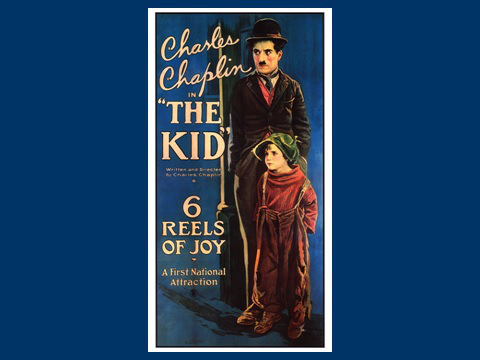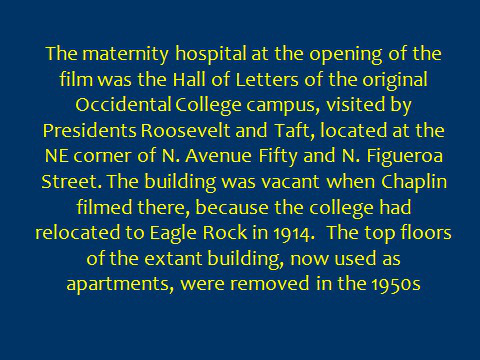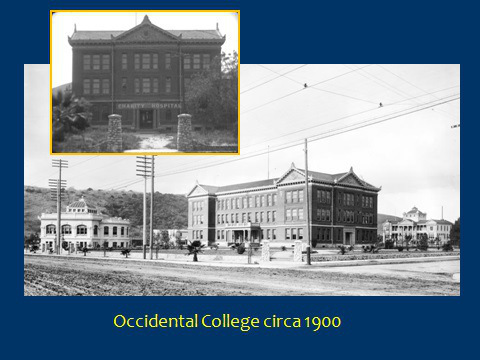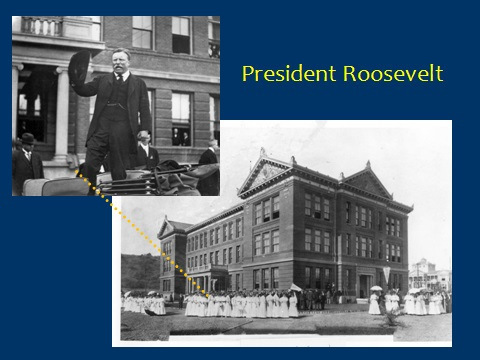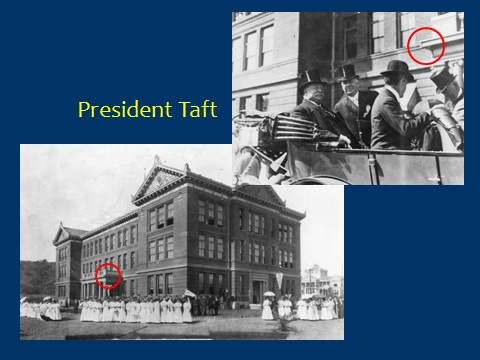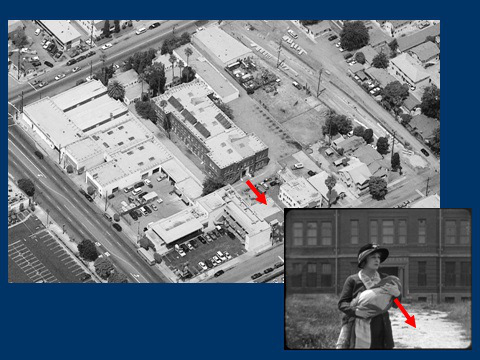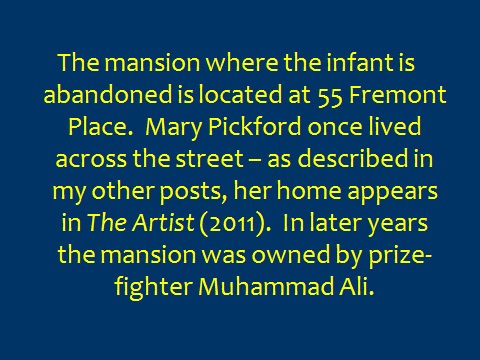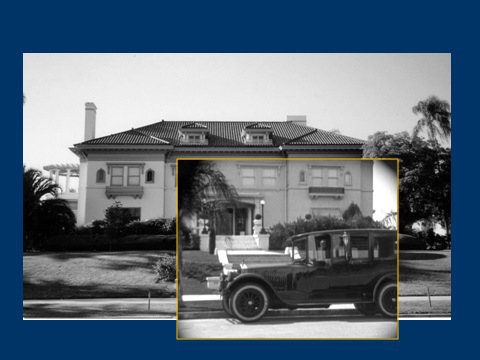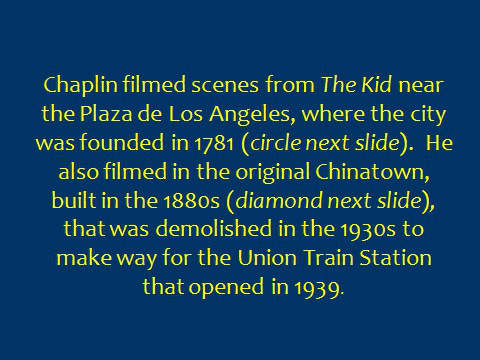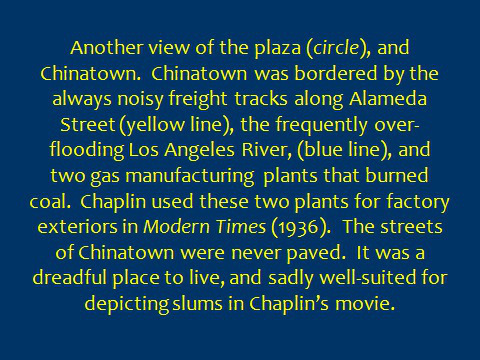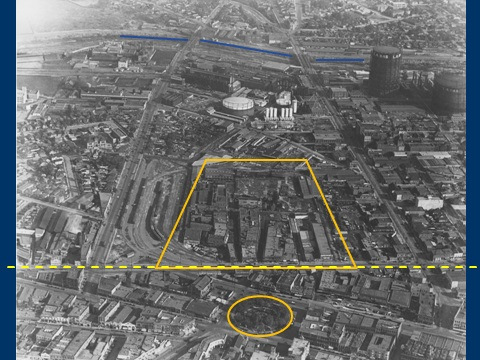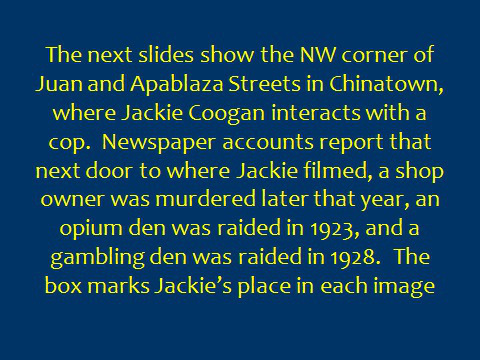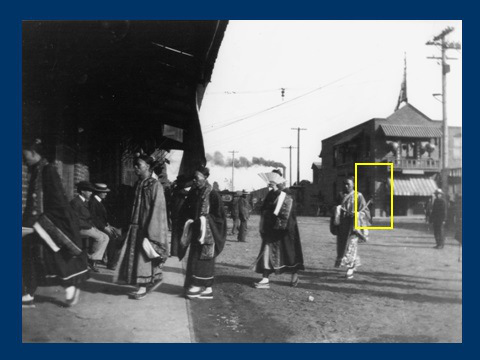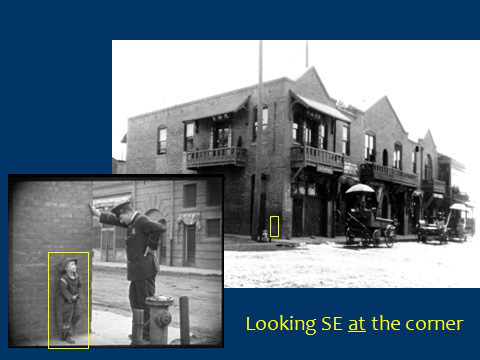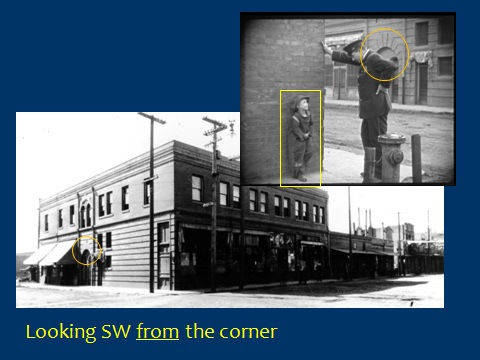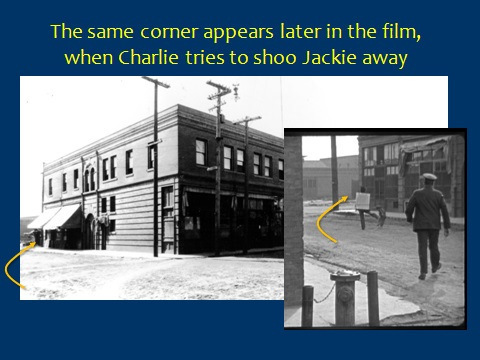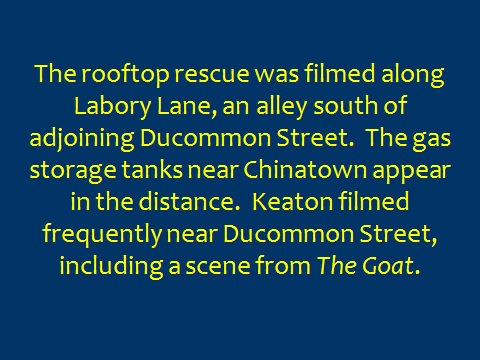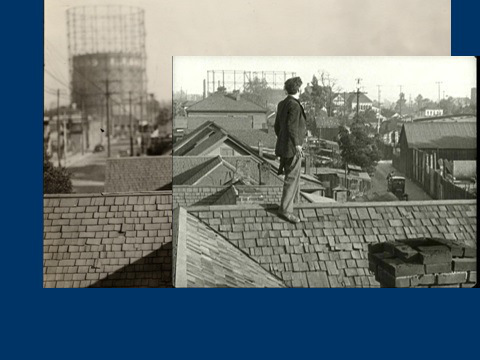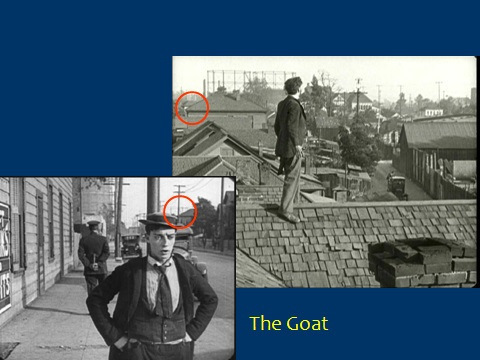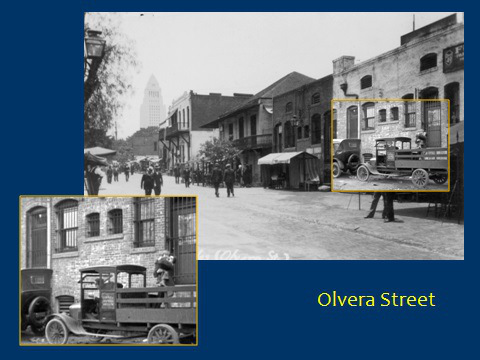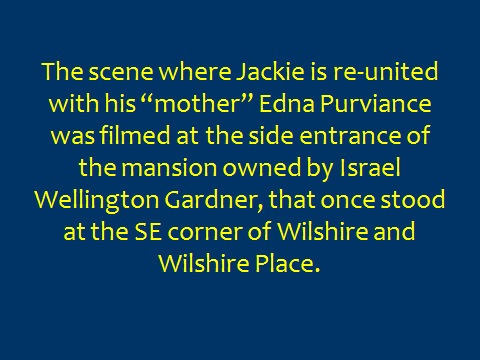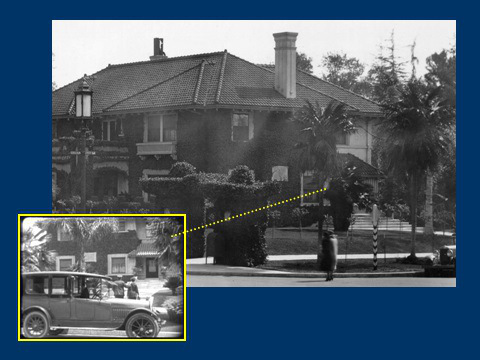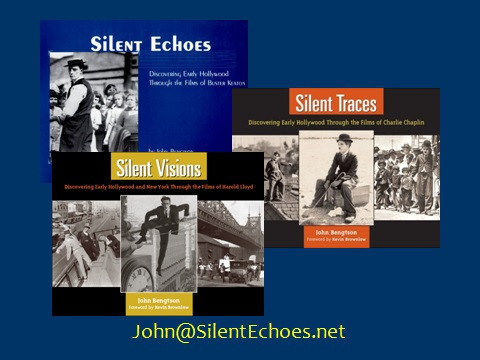John Bengtson's Blog, page 25
August 9, 2013
The Kid – Cops – Safety Last! Three comic masterpieces filmed at a common Hollywood alley you can still visit today

A moment of destiny – Charlie is about to discover “the Kid,” Buster is poised to grab a passing car. Behind them – the back and front of the same building, once a bakery, located at 1644 N. Cahuenga, in Hollywood.

Charlie first discovers “the Kid”
Charlie Chaplin encountered the abandoned infant who will become his son in The Kid (1921) along an alley running east-west between Cosmo and Cahuenga just south of and parallel to Hollywood Boulevard. A gang of police would later chase Buster Keaton down the same alley in Cops (1922), and Harold Lloyd and Bill Strother would later knock down policeman Noah Young there in Safety Last! (1923). The alley also appears in such films as Keaton’s 1920 short Neighbors, Lloyd’s 1921 short Never Weaken, and director Emory Johnson’s 1925 newspaper crime-drama The Last Edition.

Click to enlarge. Looking west, the alley runs from Cosmo (blue) towards Cahuenga (yellow). The brick box to the right of Chaplin, upper left, was an oven for the building at 1644 Cahuenga, which was originally a bakery. The overhanging second floor is supported by posts.
The Last Edition, a once-lost film restored by the San Francisco Silent Film Festival and EYE Institute Netherlands, was premiered at the 2013 Festival. Although set in San Francisco, with many identified SF locations, The Last Edition contains several scenes and pick-up shots that were actually filmed in Hollywood – a common practice with “location” movies, even today.
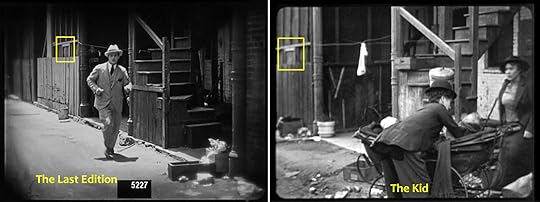
Click to enlarge. Looking south down what Google Maps calls “East Cahuenga Alley.” Clarence Walker (left) portrays a crime-busting newspaper reporter. At right, Charlie attempts to return “the Kid” to a nurse maid whom he believes to have “dropped something.” The posts support the overhanging second floor.
Aside from the San Francisco exteriors, The Last Edition provides fascinating glimpses of the San Francisco Chronicle newspaper offices and printing plant. But what really captured my attention at the premiere was a pivotal scene filmed in Hollywood along the alley where Buster Keaton filmed Cops and Harold Lloyd filmed Safety Last! (I write about Buster and Harold filming at this same alley HERE and HERE.)

Click to enlarge. Upper left, Charlie runs north past a bakery brick oven. The two lower right images show the reverse sides of the same shed.
Preservationist and San Francisco Silent Film Festival President Rob Byrne was instrumental in identifying and restoring The Last Edition, a heretofore forgotten film. After informing Rob that his movie shared some Hollywood real estate in common with Buster and Harold, Rob graciously provided me online access to the film.

Looking east – the Palmer Building at back on Cosmo Street, home coincidentally, to The Hollywood Daily Citizen newspaper. At left, Harold is mistakenly locked in a laundry wagon, and fears being late for work.
I thought some settings in The Last Edition looked familiar, and quickly realized that it provided the missing link in what I jokingly call the transitive property of film locations – that if A is filmed beside B, and B is filmed beside C, then A is filmed beside C.

Click to enlarge. The * marks a detail on the west side of Cahuenga and its east reflection in Cops.
 As I write at page 199 of my Chaplin film location book Silent Traces, I knew Charlie filmed his initial discovery of “the Kid” at the same setting where Buster had filmed scenes from Neighbors; the details in the background alleys match up. However, because both Chaplin and Keaton had filmed other scenes from these movies near Chinatown and Skid Row, I had always assumed the settings pictured here were in downtown Los Angeles as well. By providing unique views of the alley where Buster filmed Cops, and matching views of an alley appearing in Buster’s Neighbors, The Last Edition supplied the connecting link to show Chaplin filmed The Kid at this alley in Hollywood as well. The 1919 Sanborn fire insurance map depicted here shows the back of the second floor of the former bakery at 1644 Cahuenga was supported on posts overhanging the first floor, which covered a brick oven at back (more clearly seen on the 1913 map), exactly matching the movie images from The Kid.
As I write at page 199 of my Chaplin film location book Silent Traces, I knew Charlie filmed his initial discovery of “the Kid” at the same setting where Buster had filmed scenes from Neighbors; the details in the background alleys match up. However, because both Chaplin and Keaton had filmed other scenes from these movies near Chinatown and Skid Row, I had always assumed the settings pictured here were in downtown Los Angeles as well. By providing unique views of the alley where Buster filmed Cops, and matching views of an alley appearing in Buster’s Neighbors, The Last Edition supplied the connecting link to show Chaplin filmed The Kid at this alley in Hollywood as well. The 1919 Sanborn fire insurance map depicted here shows the back of the second floor of the former bakery at 1644 Cahuenga was supported on posts overhanging the first floor, which covered a brick oven at back (more clearly seen on the 1913 map), exactly matching the movie images from The Kid.

Click to enlarge. Two views of the Markham Building, at left. Harold filmed here in 1921 before the Palmer Building at back on Cosmo was constructed.

Click to enlarge. Looking west from Cosmo down the alley towards Cahuenga. At back you can still see the post supporting the second floor corner. Although now remodeled, the back of the Markham Building, which portrayed the De Vore department store in Safety Last!, stands to the right in each image. (C) 2013 Google.

Looking SE down Cosmo at the Palmer Building. (C) 2013 Google.

Looking NE up Cosmo – from Safety Last!
I can think of no Hollywood exterior that plays a greater role in silent movie history than this unique alleyway. Chaplin, Keaton, AND Lloyd each filmed scenes for one of their greatest masterpieces at this humble spot. Amazingly, the rediscovery of a forgotten film brought all of the pieces together.

Click to enlarge. Clarence Walker perches on tiptoe to eavesdrop on the crooks.
 The Last Edition contains a thrilling real-life stunt, as the reporter, played by Clarence Walker climbs up, down, and around the back of the wooden structures formerly standing at 6378-6374 Hollywood Boulevard in order to eavesdrop on the crime syndicate. As shown above, Clarence perched on an orange crate at the edge of the roof in order to reach up to the window of the room where the crooks were hatching their plan. The creaky building Walker climbs was replaced with a modern structure in 1936, adding to the documentary value of this rare footage.
The Last Edition contains a thrilling real-life stunt, as the reporter, played by Clarence Walker climbs up, down, and around the back of the wooden structures formerly standing at 6378-6374 Hollywood Boulevard in order to eavesdrop on the crime syndicate. As shown above, Clarence perched on an orange crate at the edge of the roof in order to reach up to the window of the room where the crooks were hatching their plan. The creaky building Walker climbs was replaced with a modern structure in 1936, adding to the documentary value of this rare footage.
In closing, two historic alleys bookend the tale of The Kid; the alley where Charlie first discovers the abandoned infant, and the alley where Charlie and Jackie Coogan are reunited after the authorities try to steal Jackie away into an orphanage. Remarkably both of these alleys still exist, and may be visited today. You can read about Charlie and Jackie filming their emotional reunion at Olvera Street at this post here.

Charlie and Jackie Coogan reunite on Olvera Street, today a popular Mexican marketplace and tourist attraction. Chaplin filmed here in 1921, seven years before City Hall was completed in 1928, which towers at back of this circa 1930 photo.
I wish to express my sincere thanks to Rob Byrne, the San Francisco Silent Film Festival, and EYE Film Institute Netherlands, for rescuing and restoring The Last Edition, and for their assistance with preparing this post.
All images from Chaplin films made from 1918 onwards, copyright © Roy Export Company Establishment. CHARLES CHAPLIN, CHAPLIN, and the LITTLE TRAMP, photographs from and the names of Mr. Chaplin’s films are trademarks and/or service marks of Bubbles Incorporated SA and/or Roy Export Company Establishment. Used with permission.
The Last Edition EYE Film Institute Netherlands and the San Francisco Silent Film Festival.
Cops and Neighbors licensed by Douris UK, Ltd.
HAROLD LLOYD images and the names of Mr. Lloyd’s films are all trademarks and/or service marks of Harold Lloyd Entertainment Inc. Images and movie frame images reproduced courtesy of The Harold Lloyd Trust and Harold Lloyd Entertainment Inc.
Vintage aerial photographs HollywoodPhotographs.com. Contemporary aerial view (c) 2013 Microsoft Corporation, Pictometry Bird’s Eye (c) 2010 Pictometry International Corp.
A March 2011 view west from Cosmo of the common filming site. Note: time does not stand still. The alleyway at back was recently closed to vehicles to make room for outdoor dining, and the driveway on Cahuenga leading into the Cops alley is now blocked to traffic by a raised curb and pedestrian sidewalk.
Filed under: Buster Keaton, Charlie Chaplin, Cops, Harold Lloyd, Hollywood Tour, Safety Last!, The Kid, The Last Edition Tagged: Buster Keaton, Chaplin Locations, Chaplin Tour, Charlie Chaplin, Cops, Harold Lloyd, Hollywood, Hollywood Tour, Keaton Locations, Safety Last!, Silent Comedies, Silent Movie Locations, Silent Movies, The Kid, then and now

August 2, 2013
Punky, Harold, and Harry – nine decades of film location history at Shatto Place
A panoramic view of the Modena Apartments, at 661 Shatto Place, formed by images from Harold Lloyd’s For Heaven’s Sake (1926) and the opening credits to the Punky Brewster premiere episode (1984).

Opening credits – Punky Brewster walking past 2520 W 7th Street.
In a prior post I explain how the same setting on Witmer Street appears in a Harold Lloyd silent comedy, a 1950 film noir classic, and in the recent sitcom The Office. Another post shows how early Buster Keaton comedies share settings with the popular police procedural television show Bones. Given that location filming has been taking place in Los Angeles now for over 100 years, it makes sense that certain neighborhoods have layers of cinematic history waiting to be discovered.
Actor George Gaynes portrays a photographer. In the credits he leaves a real photo shop, the Haines Photo Studio once located at 651 Shatto Place. You can make out the true 383-1473 phone number against the “555″ number added to the window.
This post was prompted by a ping-back from Lindsay Blake’s I Am Not A Stalker.com pop culture locations website, reporting that the Trebor Apartments at 2520 W 7th Street portrayed the apartment home of Punky Brewster in the 1980s NBC sitcom. Although the show, starring Soleil Moon Frye as Punky, “takes place” in Chicago, the premiere episode opening credits were likely filmed entirely in Los Angeles, despite an unsubtle shot of some Illinois license plates in a parking lot. Lindsay linked her post to mine because I had previously reported that this same apartment appears in the 1926 Harry Langdon feature comedy The Strong Man. Below you can see matching images of the Trebor Apartments from 1926 and 1984.
Click to enlarge. The Trebor Apartments (lettering barely visible above the door, left) appearing in The Strong Man and in the 80′s sitcom Punky Brewster.
During the show’s opening credits, actor George Gaynes locks up his photo shop once located at 651 Shatto Place (see above), and strolls past 1920′s era apartments located on the same block. The shot at the very top of this post of Punky was also filmed on this block.
The Pierre Crest Apartments at 673 Shatto, appearing in the show’s opening credits, and in For Heaven’s Sake. The box marks the same fire hose coupling.
Below, George continues his stroll south down Shatto Place past an actor playing a homeless man sitting beside the York Apartments.
The York Apartments, at 688 Shatto Place. Lindsay Blake made this discovery. (C) 2013 Google.
The commercial building that once housed George’s photo shop stood at the SW corner of Shatto Place and Wilshire Boulevard. Below, a wider view of George’s shop from the opening credits, and a vintage view showing the storefronts along Shatto.
Click to enlarge. The red box marks the same side entryway to the commercial building. The women are strolling south past George’s shop, once located at 651 Shatto Place.
As I will report in another post, Harry Langdon filmed many scenes from The Strong Man along Wilshire Boulevard between Shatto Place and Vermont, around the corner from where Harold Lloyd filmed.
2002 – the Shatto Place commercial building was demolished a few weeks before I visited the site. George’s photo shop was located at the far left edge of this photo. As of May 2011 the lot is still vacant.
Harold Lloyd filmed an extended scene walking north up Shatto Place for his 1926 comedy For Heaven’s Sake. In the sequence, Harold’s character discovers a misleading newspaper story has been printed about him, and attempts to purchase and discard all of a newsboy’s copies of the paper.
Harold walks north up Shatto Place beside the commercial building pictured in the show opening credits. Notice the matching diagonal sidewalk design and black granite detailing.
This view below from For Heaven’s Sake looks south down the street towards the York Apartments mentioned above, and the duplex at 3040 W. 7th Street at the end of the block.
The duplex at 3040 W. 7th Street still stands at the end of the block.
The apartments along Shatto Place were all built in 1922 and 1923, so it was a modern and fashionable neighborhood when Harold filmed there in 1926. In fact, in 1926 the storefront at the corner of Shatto Place and Wilshire was a Rolls Royce dealership!
Looking SE along Wilshire Boulevard towards the SW corner of Shatto Place. The filming described here all took place around the corner. The red box marks the Rolls Royce auto dealership sign. USC Digital Library.
As shown below, Harold filmed his scenes walking north from the Pierre Crest Apartments past the Modena Apartments and storefronts, while the Punky Brewster opening credits were filmed with George Gaynes walking south from the shop at 651 Shatto, past the Pierre Crest and York Apartments, and with Soleil Moon Frye skipping south past the Modena Apartments.
Looking to the NW at the block of Shatto Place between W. 7th (left) and Wilshire (right).
Below a grand view matching images from 1926, 1984, and 2011.
A composite view of 1926, 1984, and 2011. (C) 2013 Google.
You can learn all about how Harold Lloyd filmed For Heaven’s Sake in my book Silent Visions. You can watch the opening credits to the Punky Brewster premiere episode below.
HAROLD LLOYD images and the names of Mr. Lloyd’s films are all trademarks and/or service marks of Harold Lloyd Entertainment Inc. Images and movie frame images reproduced courtesy of The Harold Lloyd Trust and Harold Lloyd Entertainment Inc. The Strong Man (C) 1926 First National Pictures, Inc., (C) renewed 1954 Warner Brothers Pictures, Inc. Punky Brewster (C) 1984 NBC Productions.
Below, the Modena Apartments at 661 Shatto Place.
View Larger Map
Filed under: For Heaven's Sake, Harold Lloyd, Harry Langdon Tagged: For Heaven's Sake, George Gaynes, Harold Lloyd, Harry Langdon, Punky Brewster, Shatto Place, Silent Comedians, Silent Comedies, Silent Movie Locations, Silent Movies, Soleil Moon Frye, The Strong Man, then and now

July 27, 2013
Found – a new version of Keaton’s The Blacksmith – part 2, more surprises

Click to enlarge – looking west along Melrose, south of Hollywood, circa 1921. HollywoodPhotographs.com
As reported in Variety, and in my prior post, film historian Fernando Pena has topped his discovery of a complete version of the Fritz Lang 1927 epic Metropolis with a 9.5 mm print of Buster Keaton’s 1922 short The Blacksmith that contains unique scenes that do not appear in any other version of the film. Mr. Pena’s discovery prompted me to review the three different DVD or Blu-ray copies I have of the film, and I was surprised to see they differ in some respects too.
My prior post shows that Keaton built a small Chamber of Commerce set across the street from his studio to film a unique sequence in Mr. Pena’s copy of the movie. But the set also appears briefly in the Masters of Cinema version of the film below.
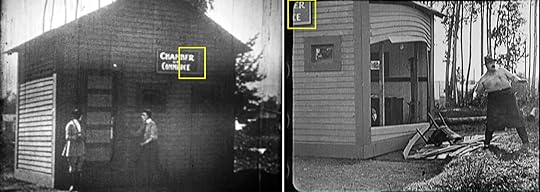
NEW FOOTAGE left – the same sign (box) appears in both scenes. Right (C) 2006 Lobster Films, Paris.
During The Blacksmith Big Joe Roberts is hauled off to jail for assaulting a sheriff. The building portraying the jail in the movie is not the Chamber of Commerce set appearing in Mr. Pena’s new footage. But later in the Masters of Cinema version, Big Joe knocks down a wall, apparently escaping from “jail,” even though you can see from the sign that it is the same Chamber of Commerce set appearing in Pena’s new footage. As Mr. Pena comments following this post below, this is one of the continuity problems in the currently available copies of the film. Mr. Pena explains that during the complete version of the film, Big Joe is actually locked away twice, both in jail, and in the Chamber of Commerce building while Buster tries to propose to Virgina Fox.

NEW FOOTAGE left, Buster rides a truck. Right (C) 2006 Lobster Films, Paris.
In Mr. Pena’s version of the film, Buster rides off from a vacant lot while sitting on some lumber extending from the back of a truck. The vacant lot stood on Cahuenga to the west of the Keaton Studio. In the background of the new footage stands the house at 1022 Cole Avenue (yellow oval), discussed at length in my prior post, and further back stands the duplex at 1017-1019 Wilcox Avenue (red box). The same vacant lot and Wilcox duplex (red box) appear during the scene (above, right) from the Masters of Cinema version, as Big Joe begins pushing his way out of the Chamber of Commerce building.
I mentioned in my prior post that Keaton filmed scenes from The Blacksmith several months apart. I’ll first establish this point, and then discuss its significance.

Click to enlarge – scene A and B were filmed at the same spot several months apart.
In scene A above, Buster is dragged east along Melrose Avenue, while in scene B an equestrian with a shock absorbing saddle bounces north up Highland. Both scenes were filmed at the NW corner of Melrose and Highland, marked with an oval in the aerial view at the top of this post; the arrow at top marks the equestrian’s path. Notice how the ridge lines in both scenes are identical, and that both scenes show the Bernheimer Estate (now Yamashiro’s Restaurant, yellow oval) and the top of the former Garden Court Apartments (red box) that once stood on Hollywood Boulevard.

Click to enlarge – the discrepancies prove scenes A and B were filmed months apart.
Although filmed at the same spot, a closer look reveals scene A and B were filmed months apart. First, the Union Oil Company once located on Santa Monica Boulevard has three tanks (yellow oval, scene B) instead of two (yellow oval, scene A). Next, the Pacific Electric Railway freight house (orange box in scene B), stands on formerly vacant land (orange line in scene A). Last, an extension of the Kerckhoff Cuzner lumber building (red box, scene B) stands on formerly vacant land (red line, scene A).
Click to enlarge – sign of the times
Looking closer still, we can see (at left) how the rooftop sign of the lumber company was correspondingly extended to match the length of the building expansion. The sign that once read “KERCKHOFF CUZNER MILL & LUMBER CO.” in scene A now reads “KERCKHOFF CUZNER MILL & LUMBER CO. – BUILDING MATERIALS” in scene B, and corresponding vintage photo.
Although The Blacksmith was reportedly shot during January – February 1922, it was held back, and released out of order on July 21, 1922, after the June 12, 1922 release of Keaton’s subsequently produced short My Wife’s Relations. Thus, a gap in filming between January 1922 and July 1922 would have allowed 4 months or so to account for the changes visible between scene A and B.

Photoplay Magazine, January 1922
While the visual clues determine there was a gap in filming The Blacksmith, it struck me that only 3 – 4 months was insufficient time to account for all of the new construction. But then Mr. Pena wrote to me explaining that Susan Buhrman had made some amazing discoveries. According to her research, a September 22, 1921 newspaper account from the Philadelphia Public Evening Ledger (below) reports that the movie originally ceased 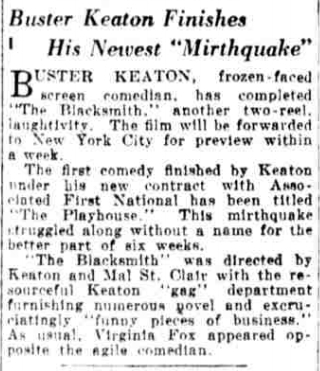 production in September 1921, and was forwarded to New York City for preview within a week. Further, the movie received a negative review in the January 1922 issue of Photoplay Magazine (above). Thus, a break in filming from between September 1921 and June or July 1922, as long as 9 months or more, would have provided far more time to account for all of the new construction (see below).
production in September 1921, and was forwarded to New York City for preview within a week. Further, the movie received a negative review in the January 1922 issue of Photoplay Magazine (above). Thus, a break in filming from between September 1921 and June or July 1922, as long as 9 months or more, would have provided far more time to account for all of the new construction (see below).
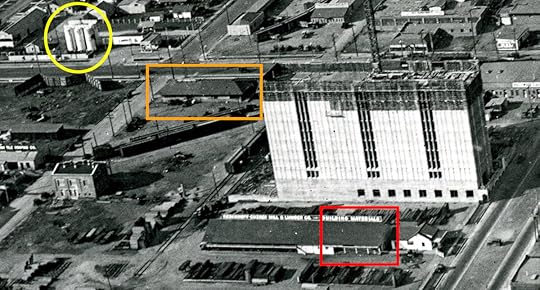
These three structures identified above were all constructed during the months-long gap in filming. Under construction at back, the landmark Hollywood Storage Co. Building, still standing at 1025 N. Highland, was completed in 1926. HollywoodPhotographs.com
These clues further establish why there came to be different versions of the film. Apparently Mr. Pena’s version was completed in 1921, quickly shipped overseas, and never returned to the United States. Thereafter, following the early negative response to the film and/or other problems, the movie was pulled from release for several months to be re-worked, and officially released domestically in July 1922.
In my next post I will show how Keaton filmed many outdoor scenes from The Blacksmith near the Pickford-Fairbanks Studio, and the Hollywood Metropolitan Studio (see top photo), and some more tantalizing distinctions between the different versions of the film.
All NEW FOOTAGE scenes provided courtesy of Mr. Fernando Pena, to whom I extend my congratulations and sincere appreciation for sharing his remarkable discovery. All other Keaton movie frame images licensed by Douris UK, Ltd.
The NW corner of Melrose and Highland today.
View Larger Map
Filed under: Uncategorized Tagged: Buster Keaton, Fernando Pena, Fritz Lang, Hollywood, Keaton Locations, Keaton Studio, Metropolis, Silent Comedians, Silent Comedies, Silent Movie Locations, Silent Movies, then and now, Variety

July 20, 2013
Found – a new version of Keaton’s The Blacksmith and the tales it tells

NEW FOOTAGE – Buster lights a stogie – a view perhaps not seen in America for 90 years

NEW FOOTAGE
As reported in Variety, lightning struck twice for film historian Fernando Pena. The same gentleman from Argentina who discovered a complete version of the Fritz Lang 1927 epic Metropolis has now unveiled a 9.5 mm print of Buster Keaton’s 1922 short The Blacksmith that contains unique scenes that do not appear in any other version of the film. For example, this new footage shows Buster behind the wheel of his jalopy, a stogie clenched proudly between his teeth, while above we see him light the cigar by using what appears to an automobile cigarette lighter. As shown below, this discovery also provides tantalizing new information about Keaton’s small studio, located in Hollywood within Lillian Way, Eleanor, Cahuenga, and Romaine.

The Keaton Studio barn as it appears in The Blacksmith, left, looking west down Eleanor towards Cahunega, and as it appears looking east from Cole Street, in Sherlock Jr. Click the photo to see the tiny barber shop (left), and at right the back of the barber shop and two bungalows, all discussed later below.

NEW – a special set
The new material runs for over four minutes, and involves novel jokes, characters, and settings that differ from the widely distributed version of the film available from Kino-Lorber. For example, the Virginia Fox character now has a father who makes an appearance, while Buster and Big Joe Roberts chase each other around a small set, barely more than a shed, designated as the local “Chamber of Commerce.” Buster also attempts to propose to Virginia, pleading he won’t always be a blacksmith, which makes more plausible their elopement later in the film.

A circa 1922 view looking SE towards the corner of the studio barn (box) and the Chamber of Commerce shed (oval) built for the novel scenes in The Blacksmith. The barber shop (1) and bungalows (2) and (3) are discussed above and below. HollywoodPhotographs.com
The Chamber of Commerce shed built for the novel scenes from The Blacksmith stood on a small vacant lot on Cahuenga directly across the street from the Keaton Studio, and appears in a couple of circa 1922 aerial photographs of the site. The tiny shed’s appearance in these photos had always puzzled me, but thanks to Mr. Pena’s discovery, I now know what the shed was and why it was there. The shed stood on the same vacant lot where Buster would later build the dormitory set for his 1927 feature College.
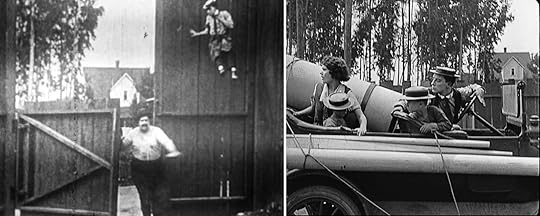
NEW FOOTAGE left – The Boat, right, both looking west from the studio towards the back of 1022 Cole Street

1022 Cole Street
The novel footage from The Blacksmith provides another view from the Keaton Studio towards the house standing to the west on 1022 Cole Street. The house not only appears behind the studio fence during scenes from The Boat (1921) (above) and in Day Dreams (1922), but also portrayed Katherine McGuire’s home (to the right) in Buster’s 1924 feature Sherlock Jr.
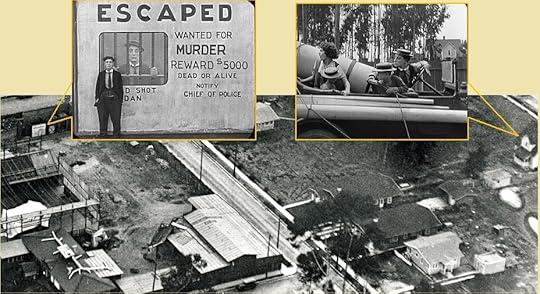
Circa 1921. At left, the ESCAPED poster set from The Goat beside the open air filming stage – at right the back of 1022 Cole Street from The Boat. The empty lot covered by both movie frames is where the Chamber of Commerce shed would later be built for The Blacksmith. The Keaton Studio barn stands at the bottom.
The new footage from The Blacksmith also helps to pinpoint the time the Keaton Studio upgraded from an open air filming stage to a more modern closed over stage. As shown above, the shooting stage remained open to the elements during the filming of Keaton’s The Goat in 1921. The novel images from The Blacksmith below show that the former open air stage was already covered over by the time filming began early in 1922, suggesting the stage construction might have taken place late in 1921.

Click to enlarge. NEW FOOTAGE at left. The view looks east from the vacant lot on Cahuenga towards the Keaton Studio across the street. By now the filming stage is covered over.

NEW FOOTAGE
During the novel scenes, Buster encounters a prop billboard that looks like an automobile, labelled with a sign that reads “The Senseless ‘Six’,” perhaps contemporary slang or a joke that eludes me. The billboard was built on the same vacant lot near the Chamber of Commerce set. The shot above shows Buster climbing from under the back of the sign. Although the above image is confusing, if you look closely you will first discern the steering wheel and the outline of the car, then further back the Keaton Studio fence across the street, with its pattern of alternating taller and shorter fence boards, and then beyond the jumble of sheds, doors, and roof edges that comprise the west side of the studio.

The covered stage, at left, in The Balloonatic
I already knew that by 1923 the Keaton filming stage was covered over, when Buster shot The Balloonatic, because you can see the covered stage in the far left background during the balloon launching scene (at right), filmed from a different vacant lot east of the studio. Buster’s famous short film Cops (1922) was filmed during December 1921 – January 1922, immediately preceding The Blacksmith. Interestingly, Cops is the only Keaton movie that has no interior scenes whatsoever. Perhaps the shooting stage roof was constructed late in 1921 during the production of Cops. Is it possible Cops was deliberately structured with no interior scenes to be filmed on the shooting stage in order to give the studio carpenters free reign to complete their work?
Of further interest, although The Blacksmith was shot during January – February 1922, it was held back, and released out of order on July 21, 1922, only after the June 12, 1922 release of Keaton’s subsequently produced short My Wife’s Relations. There is visual proof that some of the horseback scenes in “our” American Kino-Lorber version of The Blacksmith were filmed several months apart, as a number of lumberyard buildings pop up in the background between different scenes filmed at the same setting. Perhaps Mr. Pena’s version was filmed early in 1922, quickly shipped overseas, and then found to be unsatisfactory for American audiences, calling for new substitute footage to be filmed months later, perhaps even immediately before the July American release. This gap in filming would allow sufficient time for the new buildings to appear in the background, and would explain why different versions of the film exists, and why the movie was held up for domestic release. I hope to write about this gap in filming in a later post.

Click to enlarge. A circa 1920 view of the same vacant lot (center) west of the Keaton Studio. The bungalows to the right of the lot appear three times below. A tiny barber shop (discussed below) and cafe would later be built to the right of the bungalows. The prison guard towers and set from Convict 13 (1920) and the “U”-shaped tenement set from Neighbors (1920) stand in the corner of the Keaton Studio. Charlie Chaplin built his tenement set for Easy Street (1917) at the same spot. HollywoodPhotographs.com
Closing this post, above is a circa 1920 view, looking to the NW, of the small vacant lot on Cahuenga, across from Buster’s studio, where the novel Chamber of Commerce shed would later be built. Below is the back of the shed, with a matching view, looking north, of the twin bungalows across from the studio, as they appear during Keaton’s feature comedy College. The red ovals below mark a unique feature on the side of the barber shop discussed at the top of this post.

NEW FOOTAGE left, a scene from Keaton’s College, right, both looking north up Cahuenga and showing the bungalow porches across from the Keaton Studio, and the south side of the barber shop discussed above.

The Cahunega bungalows appearing in The Boat
The same bungalows on Cahuenga shown above also appear across the street (at right) during this scene from The Boat.
In all, Keaton filmed over four dozen scenes and insert shots for his movies at or adjacent to his small studio. You can read about further studio appearances in Day Dreams and in Sherlock Jr. at this prior post Mr. Keaton’s Neighborhood.

The Keaton Studio, circa 1921, within Lillian Way, Eleanor, Cahuenga, and Romaine – the barn to the upper left, with 1022 Cole Street (oval) and the vacant filming lot (brown box) across from the studio.
All NEW FOOTAGE scenes provided courtesy of Mr. Fernando Pena, to whom I extend my congratulations and sincere appreciation for sharing his remarkable discovery.
All other Keaton movie frame images licensed by Douris UK, Ltd.
Filed under: Buster Keaton, Keaton Studio, The Blacksmith Tagged: Buster Keaton, Fernando Pena, Hollywood, Keaton Locations, Keaton Studio, Metropolis, Silent Comedians, Silent Comedies, Silent Movie Locations, Silent Movies, The Blacksmith, then and now, Variety

July 17, 2013
The Last Edition 1925 – filmed in San Francisco (and LA)
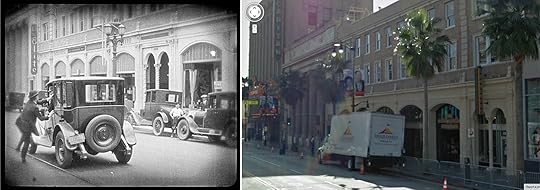
The Last Edition – the Mary Moll Building in Hollywood stands in for San Francisco. (C) 2013 Google.
The San Francisco Silent Film Festival begins Thursday, July 18. I will be signing books at the festival on Sunday, July 21, following the Kings of Comedy presentation at 10:00 a.m., and before the Safety Last! screening at 8:30 p.m. I have several posts showing how Harold Lloyd filmed Safety Last!, including two HERE and HERE.
 I am especially looking forward to the Sunday 3:30 p.m. screening of The Last Edition (1925), an adventure-drama filmed on location throughout San Francisco, including many scenes shot at the San Francisco Chronicle newspaper. As explained by Thomas Gladysz at his post, The Last Edition was considered lost until a unique surviving print was found in 2011 at EYE Film Instituut Nederland, and preserved by SFSFF President Rob Byrne.
I am especially looking forward to the Sunday 3:30 p.m. screening of The Last Edition (1925), an adventure-drama filmed on location throughout San Francisco, including many scenes shot at the San Francisco Chronicle newspaper. As explained by Thomas Gladysz at his post, The Last Edition was considered lost until a unique surviving print was found in 2011 at EYE Film Instituut Nederland, and preserved by SFSFF President Rob Byrne.
The movie’s website identifies many fascinating San Francisco settings and street corners appearing in the film, and correctly surmises that other, non-identified scenes, must have been filmed in Los Angeles instead. It was and remains a common practice for movies filmed at faraway locations to be supplemented with pickup shots filmed in Hollywood. As I explain in my book Silent Visions, Harold Lloyd’s 1928 feature Speedy, filmed extensively on location in New York, contains many sequences where Manhattan and Los Angeles street corners are edited together. Likewise, as I explain in Silent Echoes, Buster Keaton intercut trolley scenes filmed in San Francisco and Hollywood for his 1922 short film Day Dreams.
 Filling in the blanks, I identify here three Los Angeles settings appearing in The Last Edition. The first setting, above, was filmed on Hollywood Boulevard in front of the Mary Moll Building. The automobile pictured above is parked nearly in front of where Grauman’s Chinese Theater would later be built in 1927. To the right, Buster Keaton falls in front of the Mary Moll Building during the movie-within-a-movie dream sequence from Sherlock Jr. (1924).
Filling in the blanks, I identify here three Los Angeles settings appearing in The Last Edition. The first setting, above, was filmed on Hollywood Boulevard in front of the Mary Moll Building. The automobile pictured above is parked nearly in front of where Grauman’s Chinese Theater would later be built in 1927. To the right, Buster Keaton falls in front of the Mary Moll Building during the movie-within-a-movie dream sequence from Sherlock Jr. (1924).

Click to enlarge – looking up Hill Street from 6th Street. LAPL 00039492
The next view above looks north up Hill Street from 6th Street – the trees along the south side of Pershing Square appear to the left of the movie frame. The extant Hotel Clark (red box) at 426 S. Hill Street, and the former Boos Bros Cafeteria (yellow oval) at 510 S. Hill Street are identified.

The joint fire-police station appearing in The Last Edition. Photo Tommy Dangcil.
Lastly, the former joint Hollywood Fire and Police Station above, that once stood at 1625 and 1629 Cahuenga Boulevard, makes yet another silent-era film appearance. The station appeared in Buster Keaton’s feature films Three Ages (1923) and The Cameraman (1928), in Harold Lloyd’s Safety Last! (1923) and Hot Water (1924), and in the Douglas Fairbanks 1917 comedy Flirting With Fate, the 1924 Our Gang short High Society, and the 1925 Harry Langdon comedy Plain Clothes. You can read more about Keaton filming beside this fire station HERE.
The San Francisco Silent Film Festival
View Larger Map
Filed under: Uncategorized Tagged: Buster Keaton, Hollywood, Keaton Locations, Los Angeles Historic Core, San Francisco Silent Film Festival, Sherlock Jr., Silent Comedians, Silent Comedies, Silent Movie Locations, Silent Movies, Speedy, then and now

July 10, 2013
Silent Era Hollywood Tour – Cinecon 49 – Author Presentation
 Attached to this post is a self-guided written tour to Hollywood silent film locations and studios that I have prepared in connection with the “Hollywood’s Silent Echoes” presentation I will be giving Friday, August 30, 2013, at 10:30 a.m. at the Egyptian Theater, 6712 Hollywood Boulevard, as part of the Cinecon 49 – Classic Film Festival. With this tour you can follow a number of points I will cover during my presentation.
Attached to this post is a self-guided written tour to Hollywood silent film locations and studios that I have prepared in connection with the “Hollywood’s Silent Echoes” presentation I will be giving Friday, August 30, 2013, at 10:30 a.m. at the Egyptian Theater, 6712 Hollywood Boulevard, as part of the Cinecon 49 – Classic Film Festival. With this tour you can follow a number of points I will cover during my presentation.
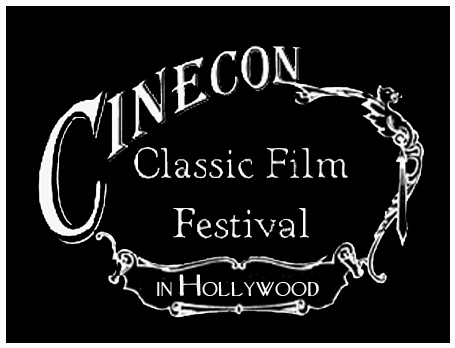 The tour starts at Hollywood and Vine, and encompasses nearly 50 filming locations and historic sites associated with Charlie Chaplin, Buster Keaton, Harold Lloyd, Douglas Fairbanks, and Harry Langdon, including several new discoveries not found in my books or previously posted tours. I look forward to seeing you at Cinecon 49!
The tour starts at Hollywood and Vine, and encompasses nearly 50 filming locations and historic sites associated with Charlie Chaplin, Buster Keaton, Harold Lloyd, Douglas Fairbanks, and Harry Langdon, including several new discoveries not found in my books or previously posted tours. I look forward to seeing you at Cinecon 49!
Hollywood’s Silent Echoes Self-Guided Tour – Cinecon 49 Classic Film Festival – 2013
Filed under: Chaplin Tour, Keaton Tour, Lloyd Tour Tagged: Buster Keaton, Chaplin Locations, Chaplin Studio, Chaplin Tour, Charlie Chaplin, Douglas Fairbanks, Harold Lloyd, Harry Langdon, Hollywood, Hollywood Tour, Keaton Locations, Keaton Studio, Lloyd Studio, Silent Comedians, Silent Comedies, Silent Movie Locations, Silent Movies, then and now

June 24, 2013
Solved at Last! – the Safety Last! Mystery Building
Harold Lloyd filmed his stunt-climbing “thrill” comedies on the rooftops of eight buildings in the downtown Los Angeles Historic Core. Remarkably, seven of these eight buildings are still standing. (In all Lloyd employed 14 buildings in one way or another – see descriptions here.)

The Dresden Apartments (yellow arrow) and California Garage (red arrow) on W 7th east of MacArthur Park
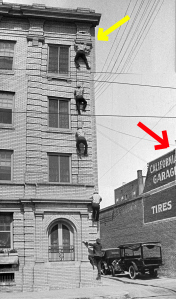
The Dresden Apartments and California Garage
But a mysterious ninth building belongs in the Lloyd Thrill Picture Hall of Fame (see left). As explained in a prior post, we learn early in Safety Last! (1923) that Harold’s roommate Bill Strother can climb tall buildings when we watch him scale a four-story apartment in order to escape from a cop. If you click the image of Bill below, you can see how the climbing was controlled with his hands.
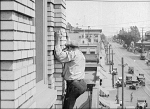
Click to enlarge – Bill Strother mid-climb
Despite an abundance of clues, including the fact the building faces an east-west trolley line, and stands beside an alley and a “California Garage” selling tires, the mystery building eluded my detection for years.
This all changed when ”Skip,” a resourceful but publicity-shy reader was able to identify the extant (if heavily remodeled) building as the former Dresden Apartments at 1919 W 7th Street. As Skip explains, he could not locate the California Garage either – there seems to be simply no historic record of this establishment. But tracking down a false lead brought Skip’s attention to the Westlake neighborhood, where he had once lived. So following hunches, and using the Bing’s Birds-Eye aerial view, Skip “flew” around the area until a four story building caught his eye. The short-long window pattern on the alley side of this building seemed unique to the area, and matched another shot from the movie.

Then and Now – the Dresden Apartments, 1919 W 7th Street. (c) 2013 Google.
As shown above, the front of the 1910 vintage building is now so badly butchered Skip was hesitant at first to contact me about it being a match. Although initially difficult to see, the remaining architectural elements match up precisely.
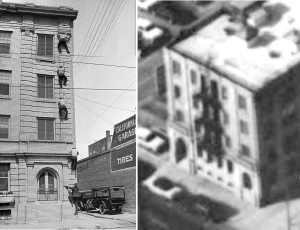
1919 W 7th Street. USC Digital Library
Moreover, vintage aerials photos (left) confirm the match, as do the distinctive parapets of the former L.A.F.D. Engine Co. No. 11 fire station at 1819 W 7th Street that appear down the street.
The Sorrento Apartments at 694 S. Burlington, on the corner of 7th Street, also appear further east down the street. Harold Lloyd filmed many scenes there for his early 1917 short comedy The Big Idea.
Below, the L.A.F.D. Engine Co. No. 11 fire house.

Click to enlarge. Looking east past Bill Strother’s cap towards the L.A.F.D. Engine Co. No. 11 – 1819 W 7th Street. Los Angeles Fire Department Historical Archive
Below, the corner of the Sorrento Apartments.
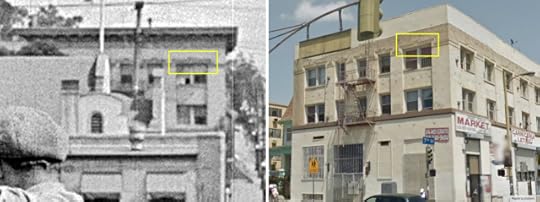
Looking further east towards the Sorrento Apartments, 694 S. Burlington. (c) 2103 Google.
Below, a 1940 view east down W 7th Street towards the Dresden Apartments. The Sorrento Apartments stand tall further down the street.
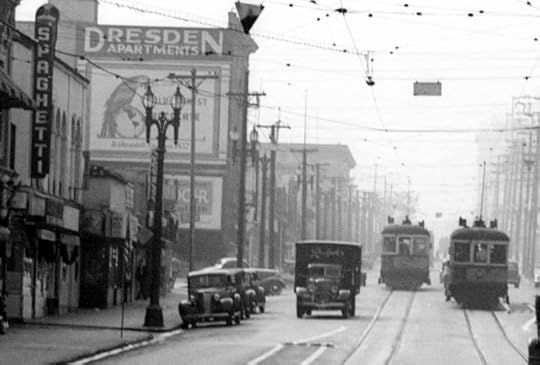
Looking east down 7th Street, circa 1940, at the Dresden and Sorrento Apartments. USC Digital Archive
The L.A.F.D. Engine Co. No. 11 fire house is still located at 1819 W. 7th Street (below), although it was completely upgraded in 1977.

L.A.F.D. Engine Co. No. 11, 1819 W. 7th Street. (c) 2013 Google.
This setting has been on the top of my Most Wanted list for years, and I want to express my gratitude to Skip both for his ingenuity in solving the puzzle, and for his kindness in sharing it. Thank you so much Skip, I really appreciate.
You can read all about how Harold Lloyd filmed Safety Last! in my book Silent Visions and in these prior posts.
A short segment from the Locations and Effects 2013 documentary with Academy-Award winning effects supervisor Craig Barron and the author filmed for the Criterion Collection release of the Safety Last! Blu-ray appears below.
HAROLD LLOYD images and the names of Mr. Lloyd’s films are all trademarks and/or service marks of Harold Lloyd Entertainment Inc. Images and movie frame images reproduced courtesy of The Harold Lloyd Trust and Harold Lloyd Entertainment Inc. Locations and Effects (C) 2013 The Criterion Collection.
View Larger Map
Filed under: Harold Lloyd, Lloyd Thrill Pictures, Safety Last! Tagged: Harold Lloyd, Hollywood, Hollywood Tour, How Harold Lloyd filmed Safety Last, Lloyd Studio, Lloyd Thrill Pictures, Los Angeles Historic Core, Man on the Clock, Safety Last!, Silent Comedians, Silent Comedies, Silent Movie Locations, Silent Movies, Stunt Climbing, then and now

June 19, 2013
How Harold Lloyd filmed the Safety Last! finale (at three places)

1 – 2 – 3 – Harold tumbles over the parapet wall, lands safely on the roof, then strolls off with Mildred
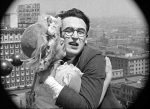
Safe at last!
Safe at last, Harold stumbles over a parapet wall into the arms of his fiance Mildred Davis, capping his hair-raising climb up the 13 story “Bolton Building” in Safety Last! Prior posts show how Harold staged the climb, and other posts reveal the Hollywood locations appearing early in the film. There is also a downtown walking tour. Seeking the perfect angle for each shot, Lloyd staged this brief scene atop three different buildings.

Above center, while still on the outside ledge of the set built atop 548 Spring Street, Harold clings desperately to Mildred, as the giant extant rooftop sign for the Hotel Rosslyn (1913) at 5th and Main appears above her head. The reversed movie image at the upper right spells out “NEW MILLION DOLLAR HOTEL ROSSLYN.” The massive sign points away from downtown in order to face what were then the three major train stations to the east, the primary mode of travel at the time. B&W photo USC Digital Library; Color photo Daniel Mayer
As the sequence begins below, Harold stumbles over the parapet from the ledge of the third and highest stunt climbing set, built for the movie atop the Merchants National Bank Building at 548 S. Spring Street. Notice the “EXAND” sign appearing above him, part of the signage for the extant Alexandria Hotel building up the street. The vertical arrow of the weather vane below cuts across the dome of the Million Dollar Theater discussed further below.
Due to the remarkable Blu-ray image quality of the new Criterion Collection release of Safety Last!, during this scene we can read the signage for the Washington Building up the street, the site of the next shot, below.

The extant Million Dollar Theater at back. (c) 2012 Microsoft Corporation, Pictometry Bird’s Eye (c) 2010 Pictometry International Corp.
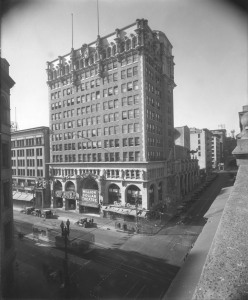
The Million Dollar Theater at 3rd and Broadway – California State Library
The scene continues with Harold stumbling over the parapet wall, and Mildred helping him to his feet. This was filmed atop the Washington Building mentioned above, at the NW corner of 3rd and Spring (arrow in modern view). Behind them stands the Million Dollar Theater built in 1917 by Sid Grauman, who would later build his famous Egyptian (1922) and Chinese (1927) theaters in Hollywood. The theater’s distinctive dome tower (box) has been a downtown landmark for over 95 years. The five-story Bradbury Building (oval) lies behind them out of view. Notice the Bradbury’s large glass atrium roof.
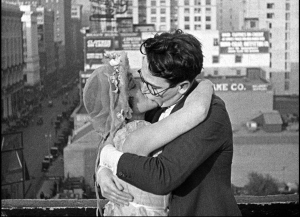 For their climatic kiss, Harold and Mildred return to 908 S. Broadway, the same building where Lloyd had previously staged the sequence hanging from the hands of the clock. This setting is readily confirmed by the distinctive wall signs appearing in the background, including the extant sign for J. EPSTEIN LADIES TAILOR on the wall of 820 S. Broadway. Harold and Mildred were married in real life on February 10, 1923, a few weeks before the movie’s April 1, 1923 premiere.
For their climatic kiss, Harold and Mildred return to 908 S. Broadway, the same building where Lloyd had previously staged the sequence hanging from the hands of the clock. This setting is readily confirmed by the distinctive wall signs appearing in the background, including the extant sign for J. EPSTEIN LADIES TAILOR on the wall of 820 S. Broadway. Harold and Mildred were married in real life on February 10, 1923, a few weeks before the movie’s April 1, 1923 premiere.
The final shot from the movie (below) showing Harold and Mildred walking off into the sunset was also filmed on the roof of 908 S. Broadway. The matching contemporary image is from the 2013 Locations and Effects documentary Academy-Award winning visual effects supervisor Craig Barron and I prepared as a supplement to the Criterion release. The view in each image looks to the Blackstone Department Store Building across the street.

Click to enlarge. The final scene from Safety Last!, with Craig Barron, center, and the author at right, as they appear in the Locations and Effects documentary included with the Criterion release.
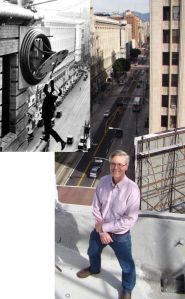
The author at 908 S. Broadway.
Based on the geometry of the publicity photographs and movie scenes, Lloyd must have built the clock-facade set on the roof of the small structure facing Harold in the above shot, the same small structure behind Craig’s right hand. As part of the new Criterion documentary, Craig has prepared an amazing 3D simulation revealing how the clock stunt effect was created. For an extra measure of authenticity, Craig, Harold Lloyd’s granddaughter Suzanne Lloyd, and I each filmed our interviews for the Criterion release in the basement of 908 S. Broadway, the building where Harold’s most famous scenes were filmed. It was an honor, and great fun, working on the program, and I hope you will check it out.
HAROLD LLOYD images and the names of Mr. Lloyd’s films are all trademarks and/or service marks of Harold Lloyd Entertainment Inc. Images and movie frame images reproduced courtesy of The Harold Lloyd Trust and Harold Lloyd Entertainment Inc. Locations and Effects (C) 2013 The Criterion Collection.
To learn more about how Harold Lloyd filmed Safety Last! be sure to check out my other posts, and my book Silent Visions.
908 S. Broadway is now home to fashion jewelry designer Tarina Tarantino’s Sparkle Factory. Tarina and her husband Alfonso Campos were so gracious to allow us to film there.
The map below identifies the three extant buildings in this post from which Harold filmed scenes for Safety Last! D marks the spot of the former triangular two-story Los Angeles Investment Co. Building near Broadway and Olympic, where Lloyd built the first (and lowest) of three rooftop stunt climbing sets.
View Larger Map
Filed under: Harold Lloyd, Lloyd Thrill Pictures, Los Angeles Historic Core, Safety Last! Tagged: Hanging from a clock, Harold Lloyd, Hollywood, How Harold Lloyd filmed Safety Last, How Harold Lloyd filmed the clock, Lloyd Studio, Lloyd Thrill Pictures, Los Angeles Historic Core, Man on the Clock, Safety Last!, Silent Comedians, Silent Comedies, Silent Movie Locations, Silent Movies, Stunt Climbing, then and now

June 15, 2013
Leave it to Harold (and Beaver) at the Long Beach Pike

 In a prior post I wrote how an idyllic Skokie, Illinois street once stood in for Mayfield on Leave it to Beaver. Although that episode has no connection to silent movies, I was surprised to see that the Season 5, Episode 21 installment “Beaver’s Fear” does. During the show older brother Wally and his cool older friends allow young Theodore to tag along on their trip to the “Bell Port” amusement park in order to qualify for a group discount. Shaken by Eddie Haskell’s constant teasing, Beaver has doubts about withstanding the roller coaster, but in the end Beaver has a great time, while Eddie freaks out, and must be carried bodily from the coach at the end of the ride.
In a prior post I wrote how an idyllic Skokie, Illinois street once stood in for Mayfield on Leave it to Beaver. Although that episode has no connection to silent movies, I was surprised to see that the Season 5, Episode 21 installment “Beaver’s Fear” does. During the show older brother Wally and his cool older friends allow young Theodore to tag along on their trip to the “Bell Port” amusement park in order to qualify for a group discount. Shaken by Eddie Haskell’s constant teasing, Beaver has doubts about withstanding the roller coaster, but in the end Beaver has a great time, while Eddie freaks out, and must be carried bodily from the coach at the end of the ride.
The former Cyclone twin-track racing roller coaster at the Long Beach Pike (1915-1968) stood in for the Bell Port attraction. Although the rear projection footage is about as convincing as Ken Osmond’s acting during the scene (see both above), it nonetheless provides a fascinating photographic record of the long lost coaster, the last twin-track (or racing) coaster in the country at the time of its demise.

Click to enlarge. The Loff Hippodrome tower, housing the Pike Carousel, appears behind Harold Lloyd during a scene from Number Please? (1920) to the left, and in the Beaver episode to the right.

The twin racing coaster was originally called the Jackrabbit Racer at the time Harold Lloyd filmed Number Please? there in 1920, but was renamed The Cyclone in 1930 after it was upgraded with higher peaks and longer drops. The Loff Hippodrome shown above and to the right housed a distinctive carousel that appeared both in Number Please? and in Buster Keaton’s 1920 comedy The High Sign.
Lloyd was not the first comedian to feature the Pike’s star attraction in an early film. Below, the Roscoe Arbuckle – Buster Keaton – Al St. John comedy The Cook (1918) also included many scenes shot on the twin-track coaster.

Click to enlarge. At left from The Cook, Al St. John streaks uphill between the twin tracks – to the right a matching shot from the Beaver episode. The curved roof of the Majestic Ballroom (and skating rink) appears at back to the right in both images.

A view of The Cyclone racing roller coaster. The tower to the Loff Hippodrome appears due north of the coaster. LAPL 00074673

Curt Gibbs (ExperienceLA):www.flickr.com/photos/experiencela/98771917
In one of my earliest posts, I write about the Long Beach Goatland attraction that appears during the Arbuckle-Keaton-St. John comedy The Cook, and how the surviving Loff Hippodrome roof and cupola tower (right) sits in a nearby parking lot. Sadly, a check on Google Street View shows that the cupola is no longer sitting in the parking lot. I have not been able to determine whether it has been safely relocated or has finally been demolished. The Pike and Silver Spray Pier were torn down long ago, although the Rainbow Harbor entertainment center that stands there today (see below) has a Ferris Wheel.
HAROLD LLOYD images and the names of Mr. Lloyd’s films are all trademarks and/or service marks of Harold Lloyd Entertainment Inc. Images and movie frame images reproduced courtesy of The Harold Lloyd Trust and Harold Lloyd Entertainment Inc.
Leave it to Beaver – (C) 1962 Revue Studios.
View Larger Map
Filed under: Buster Keaton, Harold Lloyd, Uncategorized Tagged: Al St. John, Beaver Cleaver, Cyclone roller coaster, Harold Lloyd, Hollywood, Leave it to Beaver, Loff Hippodrome, Long Beach Pike, Number Please?, roller coaster, Roscoe Arbuckle, Silent Comedians, Silent Comedies, Silent Movie Locations, Silent Movies, Silver Spray Pier, The Cook, then and now, Wally Cleaver

June 11, 2013
How Charlie Chaplin filmed The Kid
In an early post I uploaded a PowerPoint presentation highlighting some of the historic settings in Chinatown and the Plaza de Los Angeles where Chaplin filmed his early masterpiece The Kid (1921). You can download the 60 MB file here. In honor of , I am presenting a few static images from this presentation. You can read about all of the locations, many not covered here, in my book Silent Traces.
Here is a post about The Artist being filmed at the Pickford Mansion and The Kid mansion.
Here is a full post about Chaplin filming The Kid on Olvera Street
All images from Chaplin films made from 1918 onwards, copyright © Roy Export Company Establishment. CHARLES CHAPLIN, CHAPLIN, and the LITTLE TRAMP, photographs from and the names of Mr. Chaplin’s films are trademarks and/or service marks of Bubbles Incorporated SA and/or Roy Export Company Establishment. Used with permission.
Filed under: Charlie Chaplin, Chinatown, The Kid Tagged: chaplin films, Chaplin Locations, Chaplin Tour, charles chaplin, Charlie Chaplin, Chinatown, How Chaplin filmed The Kid, Olvera Street, Silent Comedians, Silent Comedies, Silent Movie Locations, Silent Movies, The Artist, The Kid, then and now















